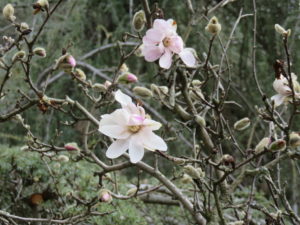‘Leonard Messel’ (Magnolia x loebneri)
If you live (and garden) in the northern climes of the U.S. and Canada, Magnolia ×loebneri Leonard Messel is an excellent choice of a flowering yard tree. It is a hybrid deciduous magnolia (M. kobus x M. stellata) (zones (4)5-9). Other similar crosses include ‘Ballerini’ and ‘Merrill’.
Leonard Messel magnolia grows to 20-30 feet tall with a rounded crown. It is more often grown in a multi-trunk form that as a single trunk tree. Flowers measure 4-6 inches across with 10-15 petals. Flowers give way to cone-like fruits that ripen in late summer with a reddish tinge; fruits split open to release individual red coated seeds suspended on slender threads. Fruits are sometimes absent on some hybrid magnolias if inadequately pollinated.
Flowering magnolias are best grown in moist, organically rich, well-drained soils and in full sun to part shade. Trees are generally intolerant of soil extremes (dry or wet) as well as to most urban pollutants. Young trees may take 3-4 years before first blooms appear. Magnolias are best sited in a site sheltered from high winds.
Leonard Messel magnolia has a multi-branched habit and start producing their lovely flowers at an early age. No serious disease or pest problems trouble this shrub when properly sited at planting. The 5-inch long, medium green obovate leaves remain blemish-free through the growing season. The gray bark of deciduous magnolias is an added plus, particularly over the winter months. Magnolias are care-free landscape trees.
New hybrid cultivars are now available in commerce featuring more compact habits and flowers that are white, blush-pink, lilac pink or pink. ‘Ballerini’ (Loebneri hybrid) produce flowers with 30 or more pure white tepals and are highly fragrant.


 Posted in
Posted in 
